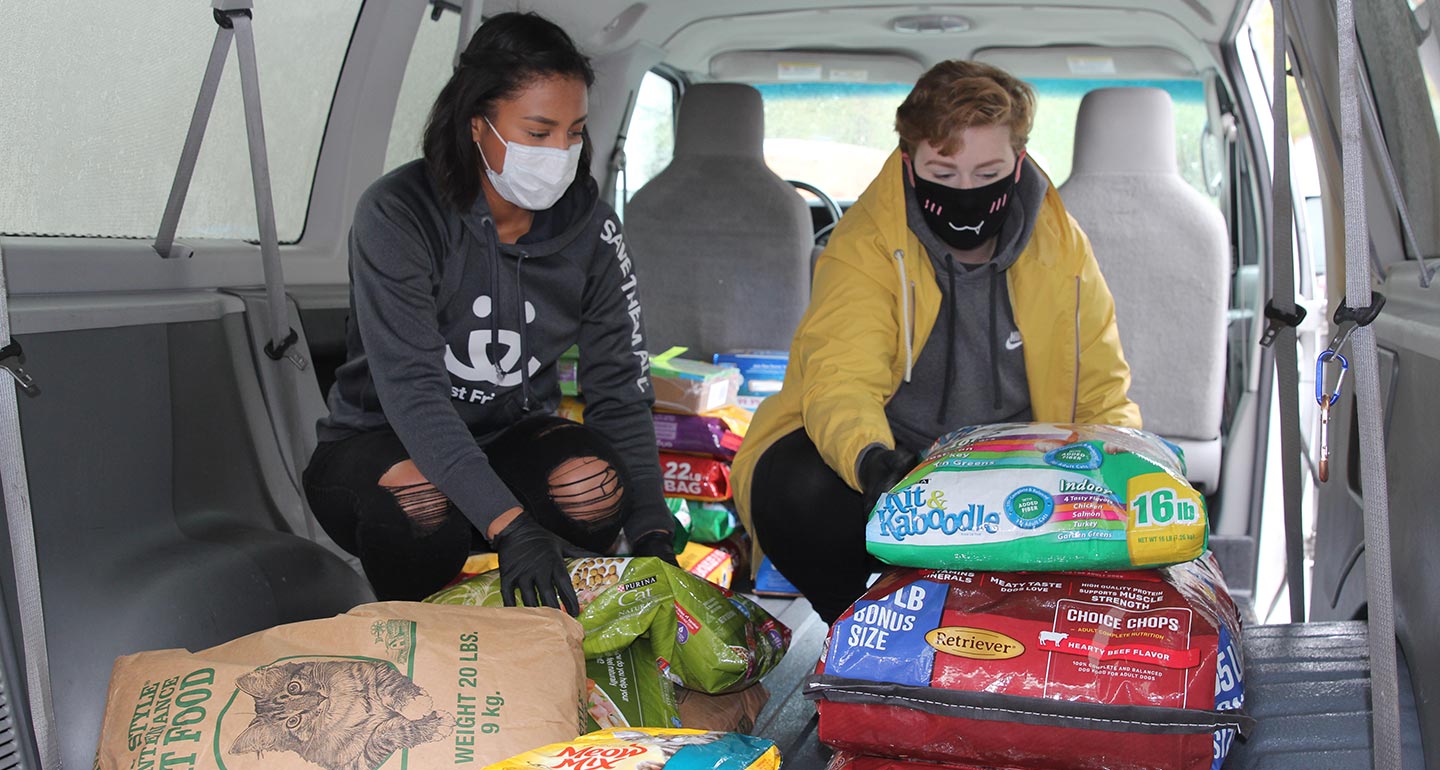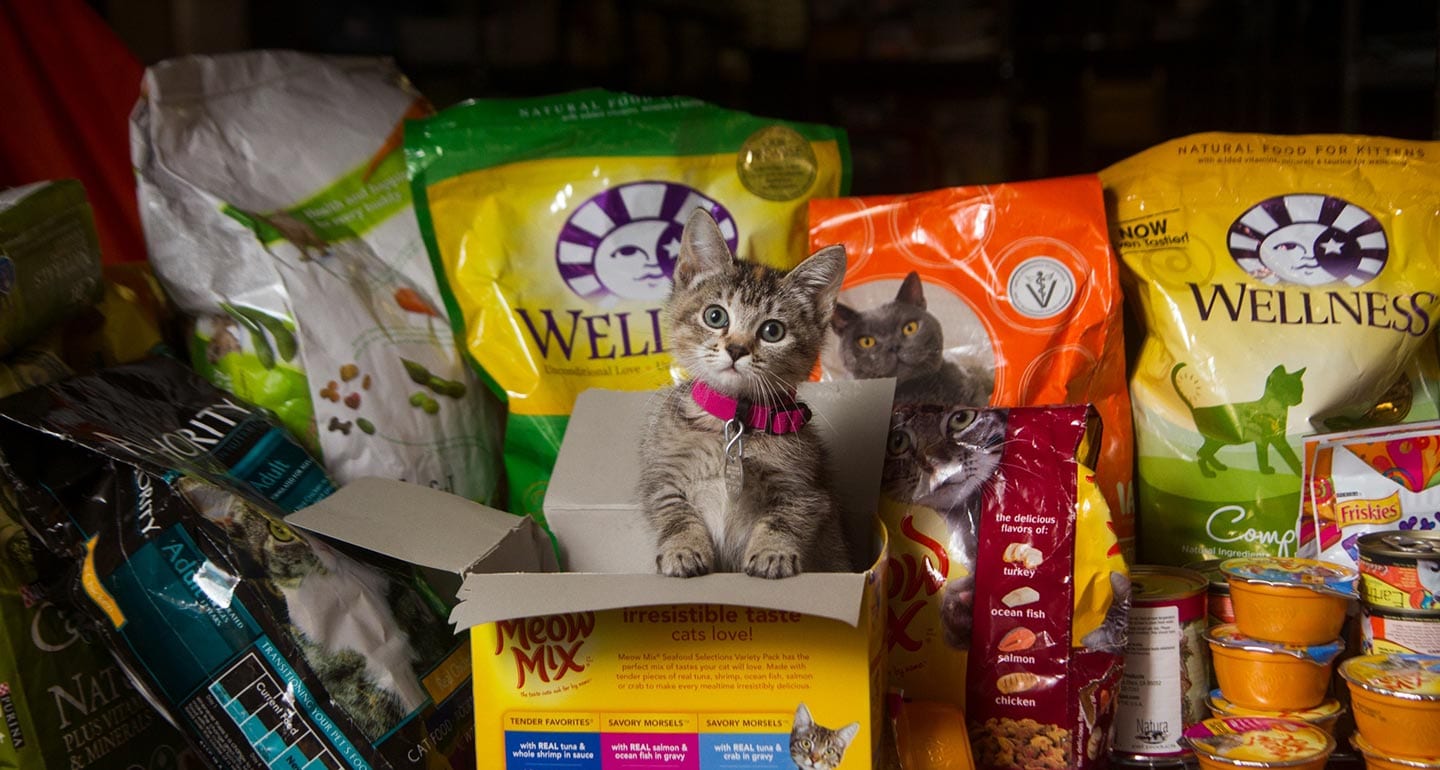
What Is a Pet Pantry?
Simply put, a pet pantry is a place or organization that provides pet food and supplies to pet parents for free or at reduced cost.
Each year, many families make a tradition out of supporting food banks that feed the people in their community who need a little extra help. But what about hungry pets? Food banks for animals have grown in popularity across the country in recent years, as generous individuals and businesses help both people and their furry friends survive through hard times.
Animal shelters, rescues and other adoption centers are the most common hosts of pet food banks, but in some cases, individual advocates step up to help pet and their parents in need.
Financial difficulty is the third most common reason why someone would surrender their pet, according to a Best Friends Animal Society analysis of Shelterluv data prior to 2020. Pet food banks aim to lessen that burden, helping as many domesticated animals as possible remain at home with their people. Mostly run by local shelters and rescues, some programs pop up as needed in their communities. For example, Austin Pets Alive! handed out 4,400 pounds of pet supplies during a one-day drive-thru in September 2020. The response was so great, staff says, that the Texas-based rescue is considering hosting another one in the future.
In other places, often in rural or poverty-stricken areas, pet parents are in need of continuing support.
Gail Posey, the founder of Posey Shelter Pet Promoters, started her pet food pantry about ten years ago, in the midst of the financial fallout of the last recession, after watching an animal being surrendered by a distraught family who couldn’t afford to feed them. Her organization helps dogs and cats in multiple ways, from rescue and adoption to trapping-neutering-and-returning (TNR) feral cats and transporting pets to low-cost spay/neuter services at a local animal hospital. But in Polk County, where the median household income is lower than the national number and the percentage of residents who live in poverty is more than double the national rate, she says the pet food pantry is one of the most impactful services the shelter offers, enabling financially struggling animal lovers to hold onto their beloved companions.
In 2019, around 95 families were able to visit the pantry once a month to pick up food for their pets. Most of the bags of cat and dog food are donated from local stores along with some extra supplies coming from individuals who want to help their neighbors. “We’ve had people break down and cry because they just didn't have the food and were able to get it from us,” Posey says. “They were just so concerned about their pets.”
These programs aren’t only making a huge difference to individual pet parents in select towns and cities. As they pop up in more cities and towns, pet food banks are also boosting the number of pets who can remain in their homes across the United States.
Since Los Angeles Animal Services opened its two Pet Food Pantry locations in South Los Angeles and Van Nuys in June of 2020, the twice monthly pantry has helped to feed 1,846 pets in the City of L.A. In Salt Lake City, Utah, the pantry at the Best Friends Lifesaving Center has distributed nearly 77,000 pounds of dog and cat food to 1,060 pets. And in West Palm Beach, Florida, Peggy’s Pantry at Peggy Adams Animal Rescue League handed out over 65,000 pounds of pet food in 2020, and continues to provide supplies to its local community.
“All of us have gone through difficult times at one point in life. The thought of having to surrender a pet for that is heartbreaking,” says David Lynch, admissions manager at Peggy Adams.

Find a Pet Food Bank Near You
If you need help feeding your pet, animal food banks can be a great resource. The first step is finding one near you. Alley Cat Rescue, a nationwide nonprofit dedicated to helping homeless cats, has a list of organizations offering pet food supplies by state. You can also type “pet food bank near me” into your search engine of choice to bring up options closest to you.
Some pet pantries require proof of residence and/or income to receive donations; however, staff say, many have become more lenient about those requirements since the start of the pandemic. Check with your local pantry for eligibility and receiving options.

How You Can Help
Those who want to support pet food banks can do so in several ways. First, find a pet food bank in your community. Then, you just have to decide how you want to help:
Donate money
Donations of cash can help pay the costs of running a pet food bank, from staffing to getting the word out to buying the food itself. Contact pet food bank programs in your community and ask how to send funds their way.
Donate supplies
The more food a shelter or rescue has to give away, the more pets get to stay together with their families. So contact your local pet food bank to find out what they need. Depending on the program and the community they serve, they may need dry food for dogs, cans of cat food, or even special diets like puppy or senior food. If your local shelter has a Chewy Wish List, you can place an order for the items they need and have your donation show up on their doorstep.
Volunteer
Pet food banks run on volunteer support, so there are tons of opportunities to help. Physically fit drivers are needed to pick up food from pantries and deliver it to homebound clients. Folks who don’t drive or have a car can chip in by distributing food to participants on pick-up days. And for those who can’t haul around 40-pound bags of food, many of these programs could use help filing, inputting data, stuffing envelopes and assisting in other less physically strenuous office tasks. Contact your local food bank program and ask how you can be useful.
Start Your Own Pet Food Bank
Though the trend is growing—and need is great—pet food banks have yet to hit every town and county in the United States. According to experts, the best way to advocate for or launch one is to team up with local rescues, then reach out to your community pet lovers, local businesses and even big pet food companies to ask for donations. Often, grocery and pet food stores can help by donating broken packages and short-dated items that they’re unable to sell, as do many veterinary offices. Most businesses are happy to see their products go to good use.
Kitty Bungalow, for example, is a Los Angeles feral cat rescue that held a one-day cat food bank for South LA and Downtown LA low-income residents who care for community cat colonies in 2020. To get supplies, the organization applied for a community food bank grant from Alley Cat Allies, which allowed them to buy food for the pantry. They also reached out to cat food brands for donations, says Melanie Wagner, Ph.D., CPDT-KA, executive director of Kitty Bungalow. In total, they were able to distribute about 460 bags of cat food to Los Angeles residents, helping to sustain hundreds of community cats.
It takes work and plenty of research to get these sort pet food banks off the ground, but for those who are involved, the gratification is well worth the time and effort. “Everybody I have seen and dealt with is very grateful,” Cox says. “It makes me feel wonderful to be able to help people, and just to know I am helping a pet not have to be hungry.”
Food banks are just one way to support pets and their families. Check out these stories for more ways to help:
Inspiring Shelter Stories
Share:









